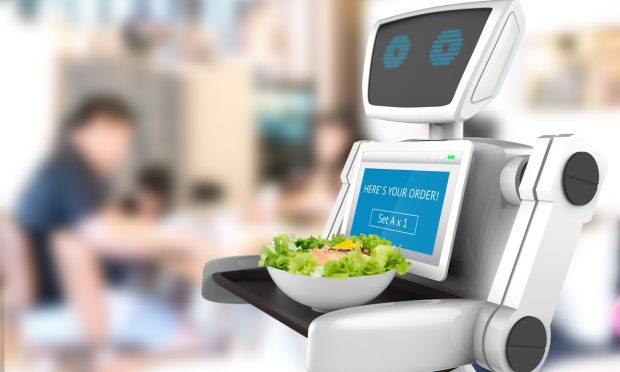Restaurant Robotics Companies Face Learning Curve Bringing Tech to Market

Restaurants continue to face a challenging labor environment with no clear end in sight. Rising wages can be difficult for many eateries to afford, especially when combined with soaring inflation putting additional pressure on the industry’s already notoriously narrow margins. As such, demand is rising for automated solutions that mitigate restaurants’ labor needs.
“Food service operators are very much struggling post-COVID. Margins were low before, they had hiring challenges before, but the post-COVID situation has just blown them out of the water,” Covahne Michaels, vice president of marketing at food service robotics company Blendid, told PYMNTS in an interview. “We’re seeing left and right not only rising costs for them, but just such difficulty in hiring that many are shutting their hours shutting down their locations, and they’re just pulling their hair out [about] how they can make a decent living moving forward.”
Restaurant employment has recovered somewhat in the past year, but increasing wages have many restaurateurs looking for lower-labor alternatives, according to data from PYMNTS’ April study “The Main Street Index: How America’s Small To Mid-Sized Businesses Are Rebuilding For A Post-Pandemic Economy,” created in collaboration with Melio.
The study, which drew from a survey of more than 500 Main Street small and medium-sized businesses (SMBs), found that restaurants’ employment scores rose 33% year over year in Q1 of 2022. Meanwhile, their Main Street Index score for wages rose 55%. Consequently, many technology companies have emerged with solutions for processes ranging from manual kitchen tasks to front-of-house service to delivery and more.
Related news: New Data Shows Main Street Businesses Rebuilding for Post-Pandemic Economy
“We’re seeing quite the explosion in automation,” Michaels said.
It’s the Little Things
Michaels argues that, with this rush to enter into the space, newer companies risk putting the cart before the horse, going all in on new technologies without necessarily identifying and solving all the challenges that can come up once these machines go live.
“A number of very talented brilliant technology engineers [are] hopping into the space,” she said, “because it’s such a growing opportunity, but many don’t have any or much experience working with food.”
For example, Blendid, which was founded in 2015, found that, early on, it would have challenges with bananas getting stuck in its smoothie machines and with fruits’ irregular shapes throwing off weight calculations.
“I think that the early-on startups that are just getting in are still going to have to realize that it takes a little while to get your feet wet,” Michaels said.
Know Your Audience
One of the learning curves for Blendid was getting to understand the differences in how consumers across demographics interact with digital technologies. Michaels noted that, while at locations on college campuses, students were quick to download ordering apps and utilize QR codes, locations inside of Walmart stores were received differently.
“During COVID, we said, ‘OK, everyone wants contactless. We’ll take away these ordering tablets and just have everyone working their phone,’” she recalled, “and that did not work in a Walmart environment. [Their customers] were not comfortable with that.”
She added that the company brought back the tablet, which worked better. Additionally, in areas with large Spanish-speaking populations, adding Spanish language messaging made a big difference.
Certainly, consumers’ comfort levels with different technologies varies considerably across age groups. Take, for instance, digital loyalty programs. PYMNTS research from the January edition of the Digital Divide series, The Digital Divide Report: Minding The Loyalty Gap, created in collaboration with Paytronix, which drew from a November survey of more than 2,400 United States adults, found that about 6 in 10 Generation Z consumers use loyalty programs at restaurants, while the share of baby boomers and seniors doing the same is roughly half that.
Read more: Restaurants Compete to Make Loyalty Programs Stand out as Consumers Join Multiple Programs
Similarly, there are significant generational gaps in aggregator usage. Research from the December edition of the Digital Divide report, “Digital Divide: Delivery Service Aggregators And The Digital Shift,” which drew from an October survey of more than 2,500 U.S. adults, found that 34% of millennials had ordered from multiple food aggregators over the previous 18 months, while only 16% of Generation Z consumers and just 1% of baby boomers and seniors said the same.
Additional details: Restaurants Must Sharpen Digital Tools to Match Convenience of Delivery Aggregators
Connecting the Dots
In the near future, Michaels expects to see robotics more seamlessly integrated into restaurant operations, with different automated systems and humans working more collaboratively.
“Hopefully, now that [food service automation] is such an emerging area, there can be more cross-collaboration with ways to approach the business,” she said.
According to research from the January issue of The Main Street Merchant Index™ (MSI), “Main Street Index: Optimism Amid Inflation Edition,” which drew from a survey of 765 Main Street U.S. business owners conducted in the late fall, 29% of businesses in the food, entertainment and accommodation segment reported that they are “very” or “extremely” likely to invest in automation/robotization of tasks that currently require manual labor. Indeed, a greater share of businesses in the segment reported an interest in these technologies than in any other segment.
See also: Two-Thirds Of US Main Street Businesses Show Optimism Despite Inflation, Economic Uncertainty
“I think we will look back at this point in time, and you’ll see that this was that pivot point where [foodservice automation] went from novel to mainstream,” Michaels said. “This is where it takes off.”
